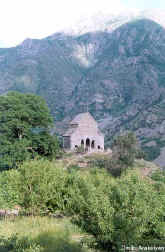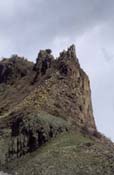
|
Returning
through Artabuynk to the main E-W paved road, one soon
reaches the village of Yeghegis
(until 1994 Alayaz), as attested by the rich
sprinkling of antiquities.
Entering the village, one sees on the right scant
remains on the Hostun city, ruined by volcano and
earthquake in Early medieval, then
Yeghegis
large khachkar
of the 12-13th c. and on the
|
|
A few km E on the
main road is Hermon,
until recently Ghavushugh. Gyuney Vank, plausibly identified
with the anciently attested monastic center Hermoni Vank, of
the 9-17th c, is somewhere nearby up a difficult
road, with S. Grigor Lusavorich church and
a 12-13th
c. cemetery.
|

|
|
left a stone
enclosure with khachkars commemorating the Orbelian family. Left on a narrow village
road takes one first to the
Astvatsatsin
basilica, rebuilt in 1703, then to a small domed 13th c.
church of S. Karapet with cemetery and then, on a green hill E of town, S.
Zorats Cathedral or S. Stepanos, built in 1303 by a grandson of
Prince Tarsayich Orbelian. The
church has been extensively restored. Its name comes allegedly from the
custom of consecrating arms and horses there before battle. In the NW part of the
village, incorporated into house and garden
walls, are substantial remains of cyclopean walls and
caves/cellars. Right of the road
inside the village is a small ruined
basilica.
In
2000, a team
from the Hebrew University of Jerusalem under Professor
Michael Stone
excavated on the S side of the Yeghegis river opposite the
village a
Jewish cemetery with some 40 gravestones with fine Hebrew
inscriptions,
attesting to the existence of a literate and prosperous
Jewish
community in Yeghegis in the years around 1289.
Somewhere on the
mountain a few km NE are ruins of 13th
c. Gyulum Bulaghi Vank (probably Upper Noravank, attested in
manuscripts).
|
|
|